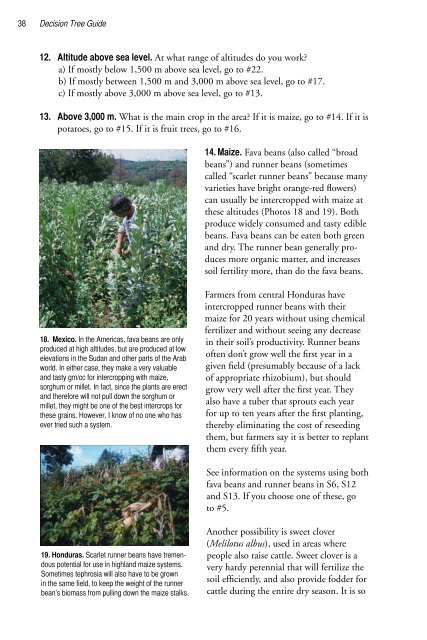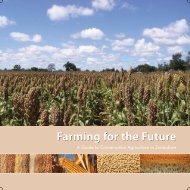Restoring the Soil - Canadian Foodgrains Bank
Restoring the Soil - Canadian Foodgrains Bank
Restoring the Soil - Canadian Foodgrains Bank
You also want an ePaper? Increase the reach of your titles
YUMPU automatically turns print PDFs into web optimized ePapers that Google loves.
38Decision Tree Guide12. Altitude above sea level. At what range of altitudes do you work?a) If mostly below 1,500 m above sea level, go to #22.b) If mostly between 1,500 m and 3,000 m above sea level, go to #17.c) If mostly above 3,000 m above sea level, go to #13.13. Above 3,000 m. What is <strong>the</strong> main crop in <strong>the</strong> area? If it is maize, go to #14. If it ispotatoes, go to #15. If it is fruit trees, go to #16.14. Maize. Fava beans (also called “broadbeans”) and runner beans (sometimescalled “scarlet runner beans” because manyvarieties have bright orange-red flowers)can usually be intercropped with maize at<strong>the</strong>se altitudes (Photos 18 and 19). Bothproduce widely consumed and tasty ediblebeans. Fava beans can be eaten both greenand dry. The runner bean generally producesmore organic matter, and increasessoil fertility more, than do <strong>the</strong> fava beans.18. Mexico. In <strong>the</strong> Americas, fava beans are onlyproduced at high altitudes, but are produced at lowelevations in <strong>the</strong> Sudan and o<strong>the</strong>r parts of <strong>the</strong> Arabworld. In ei<strong>the</strong>r case, <strong>the</strong>y make a very valuableand tasty gm/cc for intercropping with maize,sorghum or millet. In fact, since <strong>the</strong> plants are erectand <strong>the</strong>refore will not pull down <strong>the</strong> sorghum ormillet, <strong>the</strong>y might be one of <strong>the</strong> best intercrops for<strong>the</strong>se grains. However, I know of no one who hasever tried such a system.Farmers from central Honduras haveintercropped runner beans with <strong>the</strong>irmaize for 20 years without using chemicalfertilizer and without seeing any decreasein <strong>the</strong>ir soil’s productivity. Runner beansoften don’t grow well <strong>the</strong> first year in agiven field (presumably because of a lackof appropriate rhizobium), but shouldgrow very well after <strong>the</strong> first year. Theyalso have a tuber that sprouts each yearfor up to ten years after <strong>the</strong> first planting,<strong>the</strong>reby eliminating <strong>the</strong> cost of reseeding<strong>the</strong>m, but farmers say it is better to replant<strong>the</strong>m every fifth year.See information on <strong>the</strong> systems using bothfava beans and runner beans in S6, S12and S13. If you choose one of <strong>the</strong>se, goto #5.19. Honduras. Scarlet runner beans have tremendouspotential for use in highland maize systems.Sometimes tephrosia will also have to be grownin <strong>the</strong> same field, to keep <strong>the</strong> weight of <strong>the</strong> runnerbean’s biomass from pulling down <strong>the</strong> maize stalks.Ano<strong>the</strong>r possibility is sweet clover(Melilotus albus), used in areas wherepeople also raise cattle. Sweet clover is avery hardy perennial that will fertilize <strong>the</strong>soil efficiently, and also provide fodder forcattle during <strong>the</strong> entire dry season. It is so
















